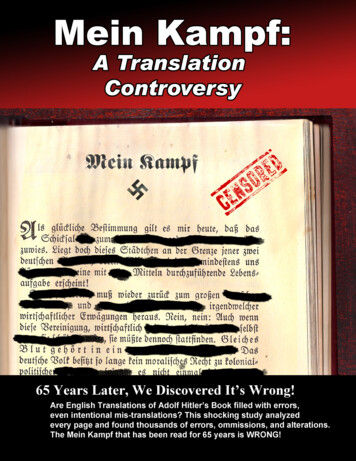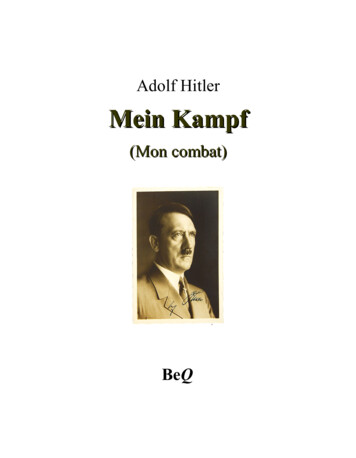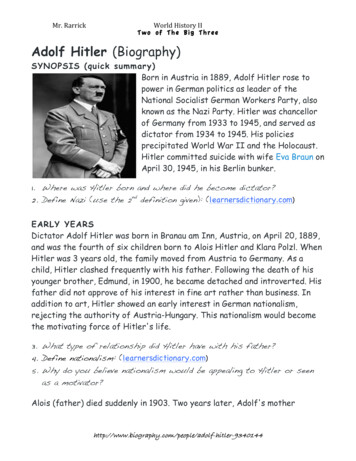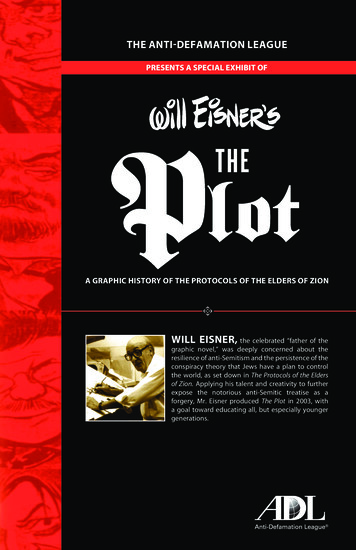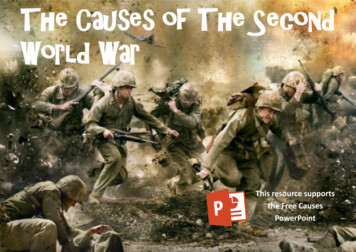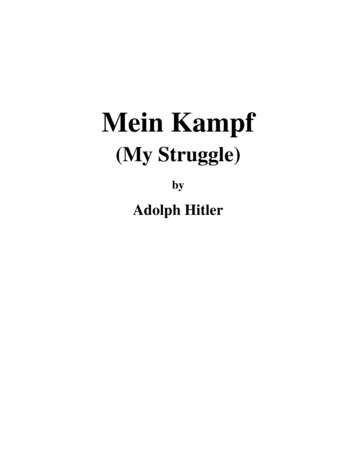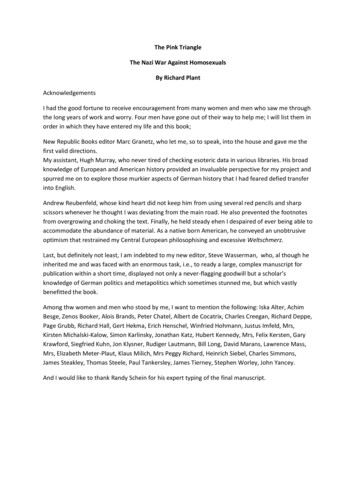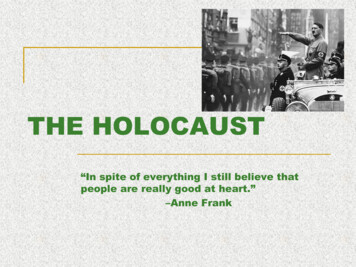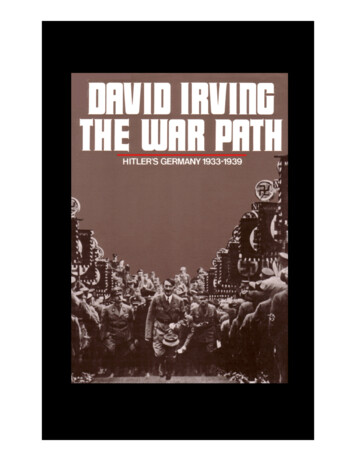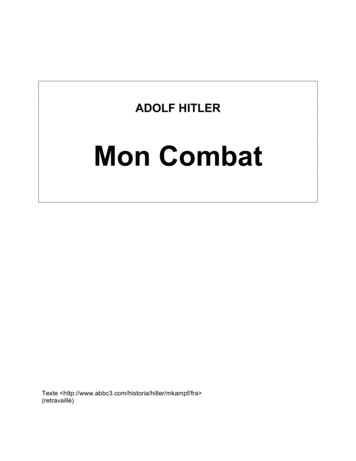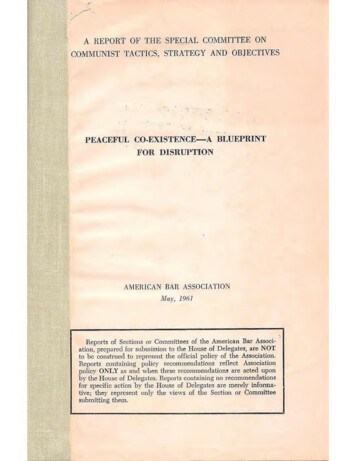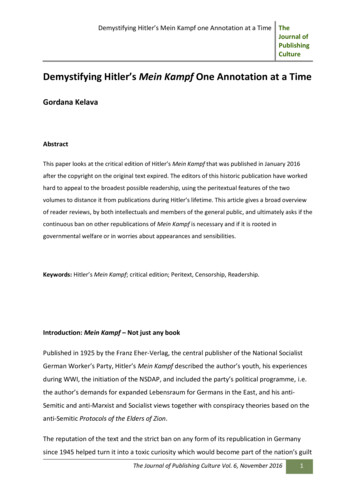
Transcription
Demystifying Hitler’s Mein Kampf one Annotation at a Time TheJournal ofPublishingCultureDemystifying Hitler’s Mein Kampf One Annotation at a TimeGordana KelavaAbstractThis paper looks at the critical edition of Hitler’s Mein Kampf that was published in January 2016after the copyright on the original text expired. The editors of this historic publication have workedhard to appeal to the broadest possible readership, using the peritextual features of the twovolumes to distance it from publications during Hitler’s lifetime. This article gives a broad overviewof reader reviews, by both intellectuals and members of the general public, and ultimately asks if thecontinuous ban on other republications of Mein Kampf is necessary and if it is rooted ingovernmental welfare or in worries about appearances and sensibilities.Keywords: Hitler’s Mein Kampf; critical edition; Peritext, Censorship, Readership.Introduction: Mein Kampf – Not just any bookPublished in 1925 by the Franz Eher-Verlag, the central publisher of the National SocialistGerman Worker’s Party, Hitler’s Mein Kampf described the author’s youth, his experiencesduring WWI, the initiation of the NSDAP, and included the party’s political programme, i.e.the author’s demands for expanded Lebensraum for Germans in the East, and his antiSemitic and anti-Marxist and Socialist views together with conspiracy theories based on theanti-Semitic Protocols of the Elders of Zion.The reputation of the text and the strict ban on any form of its republication in Germanysince 1945 helped turn it into a toxic curiosity which would become part of the nation’s guiltThe Journal of Publishing Culture Vol. 6, November 20161
Demystifying Hitler’s Mein Kampf one Annotation at a Time TheJournal ofPublishingCultureand culture and therefore aid its self-conception. Growing up in Germany in the 1980s andearly 1990s one would hear rumours about neo-Nazis importing Hitler’s text in specialeditions from other countries that did not mind publishing what Ronald S. Lauder called the“playbook for World War II and the Holocaust” (World Jewish Congress 2016). The text hadturned into a myth.The 31 December 2015 was the beginning of a new chapter in the surprising lifecycle ofMein Kampf. It was the day its copyright – which had been held by the Bavarian Ministry ofFinance – expired. Historians working for the Institute for Contemporary History have spentyears working on a critical edition of Mein Kampf that the Institute self-published in January2016, trying to demystify the book that to this day causes great pain to survivors of theShoah and to Germans alike. This critical edition – including illustrations, maps, analyses andabout 3,500 annotations - is the first of its kind and marks the first time that Mein Kampfhas been published in its entirety since its last publication in 1944. This project has not beenmet with universal acclaim and the Bavarian government even withdrew its backing afterBavaria’s premier Horst Seehofer met with Jewish leaders and heard their concerns (Range2014).Seven months after the publication of the critical edition it is time to analyse which stepsthe editors have taken to demystify Mein Kampf, to see how the readership reacted to thecritical edition, and to find out what future lies ahead for the ban on reprints.Working on Perceptions: Peritextual FeaturesOne part of the demystification process has to be done by working on peoples’ perceptions,including analysing what Gerard Genette called the paratext of a book, i.e. everything that isadded to a text by the editor, publisher, designer, printer and bookbinder. According toGenette the paratext of a book is a composite of peritext and epitext. Textual and nontextual material that make the public aware of the existence of a book – such as interviews,marketing material, reviews, etc. – form the epitext, whereas cover design, typeface,The Journal of Publishing Culture Vol. 6, November 20162
Demystifying Hitler’s Mein Kampf one Annotation at a Time TheJournal ofPublishingCultureformat, and everything else the author had little or no input on form the peritext. Peritextand epitext “surround [a book] and prolong it, precisely in order to present it, [ ] to makeit present, to assure its presence in the world, its ‘reception’ and its consumption” (Genette1991, 261). In this context it should be understood that the critical edition intends todistance itself as far as possible from any of the original Mein Kampf publications.The critical edition consists of two oversized hardcover volumes, cost effectively priced at 59EUR to make it affordable for interested individuals, teachers, academics and libraries. Thelarge format was chosen wisely and has – in comparison to what Genette suggested formost books of today – paratextual value. Mein Kampf’s first edition also appeared in twolarge format volumes but Hitler and the publisher quickly realised that the standard bibleformat (12 18.9 cm) would be more suitable for a popular edition. And indeed, the twobest known surviving editions are “pocket-sized” books, one covered in blue linen(sometimes seen with Hitler’s portrait on the dustjacket) and the so called “weddingedition” partially bound in leather. Genette referenced that the pocket book size did“constitute an undeniable selling point “ in the 1930s (Genette 1997, 19), an argumentillustrated in a documentary about Mein Kampf produced by Hitler’s propaganda machine,which used images of “Volksgenossen” of different social standings in differentcircumstances reading pocket-sized editions of the publication (Hartmann et al. 2016a,2:1759). Genette (1997, 18) pointed out that publishers traditionally used larger formats forserious publications. The critical edition refers itself back to this tradition and makes theformat one of its own selling points. It does not want to be carried around and read at thebus stop. It wants to be taken for what it is: a piece of academic work to be studied andused for reference.Both volumes of the critical edition are covered in mute grey linen to promote durability butalso to avoid attracting attention (Hartmann et al. 2016b, 1:79). The two volumes will easily“disappear” on one’s bookshelf if this is what is desired. The cover states the title of thebook including the volume, and on the same level the names of the editors. One could arguethat it was a mistake to print the first part of the title, namely Hitler, Mein Kampf, in boldThe Journal of Publishing Culture Vol. 6, November 20163
Demystifying Hitler’s Mein Kampf one Annotation at a Time TheJournal ofPublishingCultureletters, somehow stressing the first part. Further down below, where we would usually findthe name or emblem of the publisher, we find a note that this edition was commissioned bythe Institute for Contemporary History in Munich and Berlin. All writing is held in brown, setin two different fonts: the title in serifed typeface, the names of the editors and thecommissioning agency in non-serifed typeface. The back cover is kept free from any writingas are the inside front and back covers. The spine states the title of the book, the volumeand the name of the Institute.The critical edition offersseveral layers of text. Thefirst layer is Mein Kampfitself; it is the basis foreverything to come. Thistext is presented on righthand pages in Scala Serifbold. Next come theannotations consisting ofA page from the critical edition with Hitler’s original text on the right andannotations on the left and in the space around the text.text criticism andclassifications. They arearranged in a more complex way, around the basic text in Scala Serif on both the left-handpages and in the space left over on the right. According to Hartmann (2016b, 1:75) theconcept of presentation is taken from annotated bibles and the Talmud in whichinterpretations are arranged next to and around the basic text to improve readability,usability, and to allow for an easier search of information.Paging is done twofold: The page numbers of the original text is kept with its original pagenumbers but put in brackets to allow for easier referencing. The overall page numbers ofthe critical edition are kept at the bottom of the pages. The third text layer that frames thefirst two consists of foreword, preliminary remarks, historical background, explanationsabout Hitler’s way of writing, self-conception and -presentation, details about Mein Kampf,The Journal of Publishing Culture Vol. 6, November 20164
Demystifying Hitler’s Mein Kampf one Annotation at a Time TheJournal ofPublishingCulturecontextualisation of the critical edition (Volume I), acknowledgments, photos and maps, alist of translations up until 1945 including the name of the translator and the publisher, listof abbreviations, references sorted according to when they were published, indices (VolumeII).The positioning of those “official” (Genette 1991, 267) peritextual features are proof of thereference book character of the critical edition. However, the editors have gone further andhave put in a lot of thought into typography. Using Unger – the original font – seemedinadvisable since it might be illegible for modern readers and give the impression ofpromoting original publications. Trump-Antiqua was another font considered but ultimatelyrejected after it had been discovered that Georg Trump had relations to the Third Reich andthis was to be avoided (Hartmann et al. 2016b, 1:75–79).Readership and ReceptionThe Institute for Contemporary History website states that the critical edition is meant as atool for political enlightenment. It is targeted at the broadest possible readership, and bothintellectuals and members of the general public have voiced their opinion – some havingseen and investigated the actual volumes, some without having had the interest oropportunity to look into them.British scholar Jeremy Adler has expressed outrage over the re-print of the original textwhich he calls the absolute evil which one cannot annotate (Adler 2016). In an interviewwith Jasper Barenberg, Adler states that Mein Kampf still has the potential to do harm andthat he would have preferred brief brochures with explanations of the text since “the text isalready out there and therefore known”. Aforementioned Ronald S. Lauder states similarly:“Unlike other works that truly deserve to be republished as annotated editions, ‘MeinKampf’ does not. Already, academics, historians and the wider public have easy access tothis text” (World Jewish Congress 2016). Both scholars miss the obvious: Mein Kampf hasnot been available to the general public per se. Teachers could not just download excerptsThe Journal of Publishing Culture Vol. 6, November 20165
Demystifying Hitler’s Mein Kampf one Annotation at a Time TheJournal ofPublishingCultureoff the internet or use foreign editions to discuss them with their students because thatwould have been a criminal offence under Germany’s law on incitement of the people.Historian Wolfgang Benz, has given the critical edition a thorough analysis and has arguedthat several annotations should not be included while others that should be included havebeen missed. He has also questioned the point of the critical edition: Historians already hadaccess to most of the documents mentioned, and the length and depth of the two volumesmeans that few students will be able to engage critically with the work. He also doubtedthat the project will “cure anyone from anti-Semitism” (Benz 2016). In reference to thecover design journalist Götz Aly described the critical edition as wrapped in “soldierly fieldgrey linen” as worn by German soldiers in both World Wars with writing held in “subtle SAbrown”. He also criticised the annotation and reference system as being “reader unfriendly”(Aly 2016).Sven Felix Kellerhoff, journalist at German newspaper Die Welt praised the work but wishedit had been published five, ten or 20 years ago to help to process Germany’s dark past(Kellerhoff 2016). German academic Gert Ueding stated that the critical edition has exposedall of Mein Kampf’s components and has thereby explained the National Socialism’s symbolof power to its full recognisability. In his opinion the critical edition will from now on be thebasis for any further engagement with Mein Kampf (Ueding 2016).Readers of German newspaper Süddeutsche Zeitung have voiced their opinions in manyletters to the editor (Rigo, Maul, and Heinz 2016). Reader Franz-Joseph Rigo saw the criticaledition as honourable endeavour and stated that it offers “both the poison and itsantidote”. A certain Heinrich Maul did not mind the publication of the critical edition but didnot agree with using it in schools. Reader Ingo Heinz agreed with a minority of “diligent”booksellers who refuse to stock the critical edition and was convinced that the editors’actual goal was promotion for the Institute for Contemporary History.More heated – but not necessarily better informed - discussions take place in the customerreview section of the Amazon.de product website. Reviewer A C. Bock praised theThe Journal of Publishing Culture Vol. 6, November 20166
Demystifying Hitler’s Mein Kampf one Annotation at a Time TheJournal ofPublishingCultureproduction values of the critical edition but criticised “the infantilising of the Germanpublic”. T. Hugel criticised the lack of readability, while Joe6Pack called the project an“editorial overkill” and complained about the weight and format which does not allow forcasual holiday reading. Heimkehrer wished for an eBook version which would allow him totake the books along with him. Customer Steven Pfahl praised the editors’ work andProfknox criticised Amazon reviewers who saw the critical edition as an act of infantilisingand thought-policing but lacked the interest to read the two volumes himself. A customercalling himself Walter Cronkite praised the critical edition for its production quality andexcellent introduction to Mein Kampf. Customer CS described the two volumes as“beautiful” and the typeset as a “masterstroke”. Several customers recommendedinterested readers to get the original text either from international Amazon sites or aseBook from the internet.Interestingly, German right-wing newspapers seem to avoid taking part in the discussion. Asearch through online archives of the nationwide published Junge Freiheit, Zuerst! andDeutsche Stimme has only produced one article on the critical edition from 2009. This mightbe proof that Hitler’s text has lost its importance for the far-right of today, or that theeditors have eliminated every opportunity of misinterpreting the text but it might also bethe calm before the storm. At least one publisher with neo-Nazi past has declared his planto publish the original text without “do-gooder commentary” (Jüdische Allgemeine 2016).Censorship or Governmental Welfare: The continuous ban of Mein KampfIn her book on censorship Sue Curry Jansen introduced the concepts of constitutive andregulatory censorship. According to her, the powerful “invoke censorship to create, secure,and maintain their control over the power to name. This constitutive or existentialcensorship is a feature of all enduring human communities – even those communities whichoffer legislative guarantees of press freedom” (Jansen 1988, 7, 8).The Journal of Publishing Culture Vol. 6, November 20167
Demystifying Hitler’s Mein Kampf one Annotation at a Time TheJournal ofPublishingCultureIn reference to Mein Kampf it was the copyright that made the constitutive ban onrepublications possible. Now Germany is basing the continuation of the ban on two sectionsof its penal code: §86 StGB (dissemination of means of propaganda of unconstitutionalorganisations) and §130 StGB (incitement to hatred against segments of the population).However, these two sections were not invoked on texts by more eloquent members of theNazi movement: Propaganda minister Joseph Goebbels’s diaries, for example, have longbeen available in their entirety. His speech in Berlin’s Sportpalast, which had a huge impacton the German public, has been part of the public consciousness since its first broadcast in1943. It is even being used to teach German students about the art and power of rhetoric(see Currlin 2005). The use in school is key. Without confrontation with key texts of the era,young people will not and cannot understand why Mein Kampf had such impact on thepublic and how Hitler and his party could cause so much hatred, destruction and death. Thelevel of hypocrisy about which texts the general public is allowed to read and which have tobe kept in the poison cabinet can be seen as one of the signifiers Jansen has identified assigns of censorship (Jansen 1988, 8).During the press conference held on the day of the critical edition’s publication, Hitlerbiographer Ian Kershaw commented on the ban which he has long seen as problematic:“Censorship [ ] merely contributes to creating a negative myth, [ ] and inspires anunavoidable fascination in the inaccessible” (Phoenix 2016). This certainly rings true in thecase of Mein Kampf, so why does Germany keep the ban? According to Farin (2008), theBavarian Government praised itself in the past for the appreciation it has received for itsfirm stance in this matter. This was when the most Southern federal state still opposed theidea of a critical edition – the Bavarian government only decided on supporting theendeavour in 2012 when the Institute for Contemporary History had already startedworking on it (Spiegel Online 2012). From the opportunistic reactions of the Bavariangovernment to international praise and criticism one could get the impression that the banon reprinting the original text is being continued due to concerns about outsideappearances based on the symbolic character of the book and not on the intention ofprotecting the public from the actual content.The Journal of Publishing Culture Vol. 6, November 20168
Demystifying Hitler’s Mein Kampf one Annotation at a Time TheJournal ofPublishingCultureConclusionSeven months after its first official reappearance in the German market it is obvious thatMein Kampf has not set the house on fire. That does not mean, however, that it is notburning. Far-right xenophobia is omnipresent. The refugee crisis has brought out the best insome and the worst in others. Whereas some people welcome refugees with open arms,others burn down refugee shelters and spread hate and fear on social media and in public.This is not the first time this has happened after the end of the Second World War. Germanyexperienced a similar situation in the 1990s during the war in the former Yugoslavia whenBalkan refugees came to Germany. The events back then, especially the burning down of anaccommodation for refugees and asylum seekers in Rostock, Eastern Germany, where neoNazis indulged in violence while being cheered on by members of the public, should havebeen a starting signal for the project ‘critical edition’. Yes, outside appearances play a roleand Germany has to tread carefully not to hurt sensibilities of victims of the Nazi regime but“[the] discourse of egalitarian social reform is secured by talk (dialogue), not by monologuesof scholars, encyclopaedists, vanguards, and experts”(Jansen 1988, 6). In the case of MeinKampf this would require giving the public access to the text. This has happened with thecritical edition to a degree but it is only a first step. The review of the readership has shownthat some people feel infantilised if they are not allowed to make up their own mind aboutHitler’s words, some feel the representations of facts has failed. But to secure an intelligentdiscourse about the book people will demand access to the original publication so they donot feel that only the powerful (in this case governmental agencies and academics) areallowed access to Mein Kampf whereas they are kept at distance. “The inoculation of ayounger generation against the Nazi bacillus is better served by open confrontation withHitler’s words than by keeping his reviled tract in the shadows of illegality” (Range 2014).The Germany of today might be a different place if the critical edition had indeed beenpublished years ago.The Journal of Publishing Culture Vol. 6, November 20169
Demystifying Hitler’s Mein Kampf one Annotation at a Time TheJournal ofPublishingCultureReferencesAdler, Jeremy. 2016. ”Kontroverse um ‘Mein Kampf’ - ‘Dieses Buch beinhaltet noch eineGefahr’“ Deutschlandfunk. dram:article id 341871.Aly, Götz. 2016. ”Propagandaschrift von Adolf Hitler: Die neue ‘Mein Kampf’ - Editionerstickt im Detail“ Berliner Zeitung, January 1. nerstickt-im-detail-23448632.Benz, Wolfgang. 2016. ”‘Mein Kampf’: ‘Juden’: Siehe ‘Giftgas’”. Die Zeit, January mpf-neueditionbewertung/komplettansicht.Currlin, Wolfgang. 2005. ‘Goebbelsrede (Unterrichtseinheit)’. Deutscher Bildungsserver.January 28. http://www.bildungsserver.de/db/mlesen.html?Id 19438.Farin, Tim. 2008. ”Hitlers ‘Mein Kampf’: Zwischen Kritik Und Propaganda – Geschichte“.Stern.de. April 25. Genette, Gerard. 1991. ‘Introduction to the Paratext’. New Literary History 22 (2): 261–72.1997.Genette, Gerard. 1997. Paratexts: Thresholds of Interpretation. Cambridge: CambridgeUniversity Press.Hartmann, Christian, Othmar Plöckinger, Roman Töppel, Thomas Vordermayer, Adolf Hitler,Edith Raim, Angelika Reizle, Martina Seewald-Mooser, and Pascal Trees. 2016a. Hitler, MeinKampf: Eine kritische Edition. Vol. 1. Munich, Berlin: Institut für Zeitgeschichte.———. 2016b. Hitler, Mein Kampf: Eine kritische Edition. Vol. 2. Munich, Berlin: Institut fürZeitgeschichte.The Journal of Publishing Culture Vol. 6, November 201610
Demystifying Hitler’s Mein Kampf one Annotation at a Time TheJournal ofPublishingCultureJansen, Sue Curry. 1988. Censorship: The Knot That Binds Power and Knowledge. New York:Oxford University Press.Institut für Zeitgeschichte. 2015. ”Hitler, Mein Kampf. Eine kritische Edition.“ /edition-mein-kampf.Jüdische Allgemeine. 2016. “»Bild«-Zeitung: Neonazis Wollen »MeinKampf« Veröffentlichen“, May 25. 25638/highlight/mein&kampf.Kellerhoff, Sven Felix. 2016. ”Triumph Des Kleingedruckten“. Welt Online, January 9.http://www.welt.de/print/die ckten.html.Phoenix. 2016. Buchvorstellung: ‘Hitler, Mein Kampf. Eine Kritische Edition’ am 08.01.2016.https://www.youtube.com/watch?v x7htvL-OPw8.Range, Peter Ross. 2014. ”Should Germans Read ‘Mein Kampf’?” The New York Times, July -germans-read-mein-kampf.html.Rigo, Franz-Joseph, Heinrich Maul, and Ingo Heinz. 2016. ‘Ihre Post: ‘Mein Kampf’ - Gift undGegengift’. sueddeutsche.de, January 15. und-gegengift-1.2819638.Spiegel Online. 2012. ”Bayerns Urheberrecht: ‘Mein Kampf’ wird Schulbuch“, April -a-829502.html.Ueding, Gert. 2016. ‘Versachlichung des Gegenteils’. Der Freitag, January achlichung-des-gegenteils.World Jewish Congress. 2016. “Lauder: ‘Mein Kampf should be left in poison cabinet ofhistory’”. Online, 8 January 2016. ory-1-5-2016.The Journal of Publishing Culture Vol. 6, November 201611
Mein Kampf’s first edition also appeared in two . The back cover is kept free from any writing as are the inside front and back covers. The spine states the title of the book, the volume . not been available to the general public per se. Teachers could not just download excerpts . Demystifying Hit
